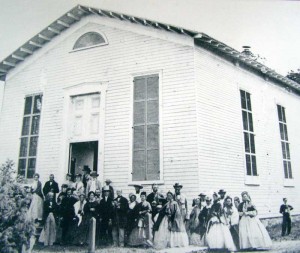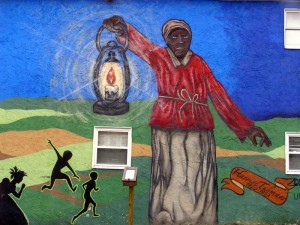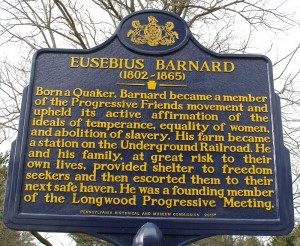Chester County offered hope and a route to freedom for slaves
By Gene Pisasale, Special to The Times

The Progressive Friends Meeting House in Kennett is now the Chester County Visitors Center — but was a key border hub in the movement of slaves north of the Mason-Dixon Line and freedom.
More than any other issue, the Civil War was fought to decide whether “the peculiar institution” known as slavery would continue to be the law of the land. Although having been in existence for centuries in many other countries- where even blacks owned other blacks as slaves- some brave citizens found the practice so abhorrent, they dedicated themselves to its abolition. The actions of people assisting slaves on their trek to freedom, clandestinely through back alleys in the dark of night gave rise to the term Underground Railroad.
As a free state, Pennsylvania became a haven for slaves crossing the Mason-Dixon Line. In the mid 1800’s, Chester county had many Quakers, the pacifist sect that abhorred violence. Although a few Quakers actually owned slaves, most were strongly against the practice. For many of them, the “final straw” was the passage of the Fugitive Slave Act, which brought the force of the Federal government on individuals who aided in the transport of slaves away from their owners. Proximity to the slave states of Delaware and Maryland caused Kennett Square to become a hotbed of abolitionist activity, a refuge for hundreds of escapees as they sought a better life in the North. R.C. Smedley wrote the seminal work on the local Underground Railroad in 1882 titled “History of the Underground Railroad in Chester and the Neighboring Counties of Pennsylvania” which details persons actively involved in this effort.
The building which now houses the Chester County Visitors Center was constructed by the Progressive Quakers and currently contains a display highlighting the history of the abolitionist movement in the region. Activist Frederick Douglass spoke there, as did poet John Greenleaf Whittier and abolitionist William Lloyd Garrison. Local historian Mary Dugan is a cordial woman who conducts Kennett Underground Heritage Tours and offers a wealth of knowledge concerning 28 sites listed on their historical map of southern Chester County.
Who were these heroes? Why did they risk their own safety for the defense of other people? The answer lies in the human heart. They believed in the saying “The only thing necessary for evil to exist in this world is for good people to do nothing.” There were many good people in and around the Kennett Square area who did help and they deserve mention.

This mural from the Kennett Underground Railway Museum — currently awaiting it’s new home in Pocopson — tells the story of the often difficult trip north to freedom for slaves.
John and Hanna Cox owned the Longwood Farm and the house which now stands boarded up along Baltimore Pike. The Cox’s were “station masters” who at great risk to themselves guided many blacks to freedom. Harriet Beecher Stowe visited them and is said to have based part of her book “Uncle Tom’s Cabin” on events she witnessed there. President Abraham Lincoln brought attention to the author visiting him at the White House, saying “You’re the woman who wrote the book that started this great war.”
Another house in the area was previously the residence of Dr. Sumner Stebbins; he and his wife Mary Ann helped many escapees. The whitewashed building sits quietly outside Kennett Square, a summer breeze whistling through its maroon shutters. A dark blue historical marker is on the lawn of the Eusebius Barnard House in nearby Pocopson. The sign details his prominent role in the Quaker community and efforts to rescue African-Americans in need. The structure was a stop on the Underground Railroad and is projected to be the future home of the Underground Railroad Museum. Just down Rte. 52 near the Delaware state line is the home of the Mendenhall family who were among the first people escaped slaves met on their journey through Wilmington. The Mendenhall Inn is a reminder of this rich heritage.

The Barnard House in Pocopson was a stop on the Underground Railway — and is slated to become the new home of the Kennett Underground Railway Museum.
In Longwood Cemetery stand the gravestones of some of these heroes who furthered the cause of freedom. In 2010, local businessman Darryl Hall commissioned the painting of a mural honoring people who were part of the Underground Railroad. The work is on the side of a building off Willow and State Streets approaching downtown Kennett Square. Sharp hues highlight Harriet Tubman, a major figure in the abolitionist movement. She’s holding a lantern, guiding weary travelers in the darkness. Her eyes engage the viewer, as if to say “The freedom you have now is partly due to our courage, standing up for our beliefs…” There will be a First Friday stroll highlighting the history of the local Underground Railroad in June 2012. Stop in and see the mural… and think for a moment about how some brave souls risked their lives for the liberties we all enjoy today.
To learn more about the Underground Railroad, visit www.undergroundrr.kennett.net .
Gene Pisasale is the author of “Lafayette’s Gold- The Lost Brandywine Treasure”, an historical novel of the Chester County area. His website is www.GenePisasale.com; he can be reached at Ge**@**********le.com .




